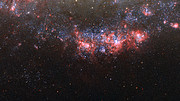Figure 1:
Barred spiral galaxy NGC 7479 was Suprime-Cam's final target from
Subaru Telescope. This color image is a composite of g', r', i', and
NA656 band images. (Credit: NAOJ, Data processed by Dr. Ichi Tanaka)
Suprime-Cam, the wide-field imager mounted at the primary focus of the
Subaru Telescope, had its final night of observation on May 29, 2017.
The instrument's wide-field imaging capability – 200 times larger than
that of Hubble Space Telescope – coupled with sensitive CCD detectors,
Subaru's large mirror, and superb weather conditions on Maunakea, gave
Suprime-Cam unique imaging power. Some scientists consider it to be the
driving force of modern observational astronomy. Since its first
observation in 1999, Suprime-Cam made countless discoveries, and has
repeatedly broken a world record for the most distant galaxy ever
observed.
Three groups of scientists came together for Suprime-Cam's final
night of observation, and spotted asteroids, galaxies, and supermassive
black holes. Before sunrise, the observers held a ceremony and
celebrated the camera's contributions to astronomy.
At the remote observing room in the headquarters of the National
Astronomical Observatory of Japan (NAOJ) in Mitaka, Tokyo, astronomers
and engineers gathered to share the experience. One of them was
Professor Sadanori Okamura from Hosei University, a key figure in the
development of Suprime-Cam. Professor Okamura shared stories of the
trials, tribulations, and triumphs, that contributed to the camera's
successful journey.
Suprime-Cam's final target was NGC 7479, a barred spiral galaxy about
100 million light-years away in the direction of the constellation
Pegasus. Professor Okamura first observed this galaxy in 1970s at the
Okayama Astrophysical Observatory in Japan for a morphological study. He
built the basis for galaxy imaging observations in Japan, and his work
was internationally recognized. He also advanced extragalactic astronomy
by using wide-field imaging observations, and his research activities
directly led to Suprime-Cam's development.
NGC 7479 had never been observed by the Subaru Telescope. The
resulting image shows clear and detailed structures of a star-forming
region that was not visible in 1970s photographic plates. This
high-quality imaging data was the "Final Light" that Suprime-Cam
captured, and it will create opportunities for even more study.
Figure 2: Observation team pointing the telescope to Suprime-Cam's final target: NGC 7479.
Credit: NAOJ
The Subaru Telescope was specially built to mount Suprime-Cam at its
prime focus at the top of the telescope. That placement allows a wide
field of view, an arrangement unique to the Subaru Telescope. The
technological advancements and expertise that emerged from Suprime-Cam
have been inherited by its successor, the Hyper Suprime-Cam (HSC).
With a field of view seven times larger than Suprime-Cam, HSC has
been in operation for open use since March 2014. "HSC has already
brought revolutionary results in various astronomical fields," said
Professor Okamura, "and it is the world's most powerful wide field
imaging camera. After Suprime-Cam, I expect HSC will pioneer new
advances in observational astronomy."
Figure 3: Many people gathered at the remote observing
room in Mitaka, Tokyo (left) and at the summit observing room on
Maunakea (right) to watch the final observations made by Suprime-Cam on
Subaru Telescope.































